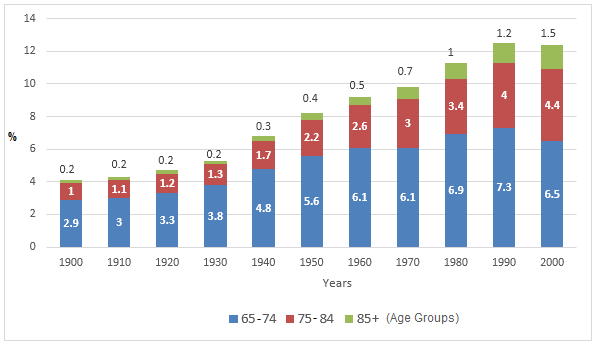IELTS graph 316 - US population aged 65 and over
- Details
- Last Updated: Monday, 28 June 2021 18:40
- Written by IELTS Mentor
- Hits: 61100
IELTS Academic Writing Task 1/ Graph Writing - Bar Graph + Pie Charts:
You should spend about 20 minutes on this task.
The chart below shows the percentage of the total US population aged 65 and over between 1900 and 2000.
Summarise the information by selecting and reporting the main features, and make comparisons where relevant.
You should write at least 150 words.
Percent of the Total Population age 65 and over between 1900 to 2000 in the USA.

Source: U.S. Census Bureau, decennial census of population, 1900 to 2000.
Sample Answer 1:
The column graph summarises the percentages of elderly citizens in the USA who were above 64 years old between 1900 and 2000 based on the U.S. Census Bureau's decennial census of population data.
Generally speaking, the ratio of senior citizens in the USA increased significantly over the period, and 65 to 74 years old citizens were the highest in percentage in terms of their ratio among the elderly Americans.
According to the graph, four out of hundred Americans were above 64 years old in 1900 and the majority of them were between 65 to 74 years old at that time. Moreover, the ratio of people over 85 years old in this decade was very insignificant. After three decades, however, the elderly people’s ratio in the US reached over 5% and it kept on increasing until the end of the 20th century. Thus, almost one in ten US citizens was elderly in 1970 and 0.7% of them were 85 years old. The growth of senior citizens further accelerated after 1980 in the USA. As a consequence, during the last two decades of the 20th century, the USA had been the home to 12% of senior citizens and almost 4.5% of them were between 75 to 84 years old and 1.5% above 85 years old.
Sample Answer 2:
The column graph depicts the percentages of senior citizens in the USA throughout the 20th century according to the decennial census population data of the U.S. Census Bureau.
Generally speaking, elderly people in the USA increased over the period of 1900 to 2000. 65 to 74 years old citizens were highest in percentage among elderly Americans during this time.
As can be seen in the chart, four out of every hundred Americans were over 64 years old in 1900. Moreover, the ratio of people over 85 years old in this year was insignificant. During the first three decades, the percentage of elderly people in the USA increased by merely 1%, and there was no change in the percentage of citizens aged over 85 years.
Then in the next sixty years, the percentage of senior citizens surged to a maximum of over 12% of the total population. However, in the last ten years of the century, the number dropped slightly. By the year 2000 majority of elderly people were between 65 to 74, which was 6.5%, and the citizens aged 85+ were only 1.5%.
[Written by - Kasun Madusanka Silva]


Overall, elderly people's percentage in the USA increased gradually and steadily throughout the century.
In detail, the elderly people constituted just less than 6% of the total American population from 1900 to 1930. But within the next 4 decades, their proportion rose significantly and in 1970, every one in ten Americans were over 64 years old. This rate kept on increasing, and in 1990, the USA had almost 13% population who were over 64 years old.
Elderly people, who were between 65 and 74 years, made up the largest proportion of senior citizens in the USA. In 1900, when the ratio of elderly was just 4%, the 65-74 age group constituted almost three-fourths of them. In 2000, their ratio was 6.5% while 75-84 made up 4% and the rest of the 13% were over 85 years old.
Report